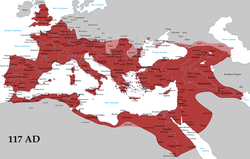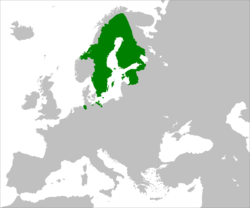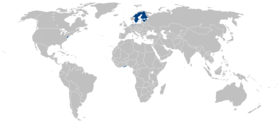Roman Empire
| Roman Empire | ||||||
|
||||||
|
||||||
|
||||||
| Capital | Rome (27–) Mediolanum (286–402,Western) Augusta Treverorum Sirmium Ravenna (402–476, Western) Nicomedia (286–330,Eastern) Constantinople (330–1453, Eastern) Syracuse (663–669, Eastern) |
|||||
| Languages |
|
|||||
| Religion |
|
|||||
| Government | Mixed, functionallyabsolute monarchy | |||||
| Emperor | ||||||
| • | 27 BC – AD 14 | Augustus (first) | ||||
| • | 98–117 | Trajan | ||||
| • | 284–305 | Diocletian | ||||
| • | 306–337 | Constantine I | ||||
| • | 379–395 | Theodosius Ia | ||||
| • | 474–480 | Julius Neposb | ||||
| • | 527–565 | Justinian I | ||||
| • | 976–1025 | Basil II | ||||
| • | 1449–1453 | Constantine XIc | ||||
| Legislature | Senate | |||||
| Historical era | Classical era to Late Middle Ages | |||||
| • | Final War of the Roman Republic |
32–30 BC | ||||
| • | Empire established | 30–2 BC | ||||
| • | Constantinople becomes capital |
330 | ||||
| • | Final East West divide | 395 | ||||
| • | Fall of the Western Roman Empire | 476 | ||||
| • | Fourth Crusade | 1202–1204 | ||||
| • | Reconquest of Constantinople | 1261 | ||||
| • | Fall of Constantinople | 29 May 1453 | ||||
| Area | ||||||
| • | 25 BC[2][3] | 2,750,000 km²(1,061,781 sq mi) | ||||
| • | 117 AD [2][4] | 5,000,000 km²(1,930,511 sq mi) | ||||
| • | 390 AD [2] | 4,400,000 km²(1,698,849 sq mi) | ||||
| Population | ||||||
| • | 25 BC[2][3] est. | 56,800,000 | ||||
| Density | 20.7 /km² (53.5 /sq mi) | |||||
| Currency | Sestertius,b Aureus,Solidus, Nomisma | |||||
| Today part of | ||||||
|
||||||
| Warning: Value not specified for “common_name“ | ||||||
The Roman Empire (Latin: Imperium Rōmānum; Classical Latin: [ɪmˈpɛ.ri.ũː roːˈmaː.nũː] Koine and Medieval Greek: Βασιλεία τῶν Ῥωμαίων,tr. Basileia tōn Rhōmaiōn) was the post-Roman Republic period of theancient Roman civilization, characterized by government headed byemperors and large territorial holdings around the Mediterranean Sea in Europe, Africa and Asia. The city of Rome was the largest city in the worldc. 100 BC – c. 400 AD, with Constantinople (New Rome) becoming the largest around 500 AD,[5] and the Empire’s populace grew to an estimated 50 to 90 million inhabitants (roughly 20% of the world’s population at the time).[6] The 500-year-old republic which preceded it was severely destabilized in a series of civil wars and political conflict, during which Julius Caesar was appointed as perpetual dictator and then assassinated in 44 BC. Civil wars and executions continued, culminating in the victory of Octavian, Caesar’s adopted son, over Mark Antony andCleopatra at the Battle of Actium in 31 BC and the annexation of Egypt. Octavian’s power was then unassailable and in 27 BC the Roman Senate formally granted him overarching power and the new title Augustus, effectively marking the end of the Roman Republic.
Norwegian Empire
|
|
|
| Hereditary Realm of Norway | ||||||
| Greater Norway 1027a – 1814b | ||||||
|
||||||
|
||||||
|
Norway at its greatest extent, from 1263
|
||||||
| Capital |
|
|||||
| Languages |
Majority languages: Minority languages: Lingua franca: Writing system:
|
|||||
| Religion |
|
|||||
| Demonym | Norwegian Synonyms: |
|||||
| Government | Feudal monarchy | |||||
| Monarch | ||||||
| • | 872–932 | Harald I first | ||||
| • | 1299–1319 | Haakon V last | ||||
| Legislature | Council of Realm c. 1300 – 1536 |
|||||
| Historical era | Middle Ages | |||||
| • | Established | 872 | ||||
| • | Disestablished | 8 May 1319 | ||||
| Area | ||||||
| • | 1263c | 2,322,755 km²(896,821 sq mi) | ||||
| Currency | Norwegian penning 995 – 1513 |
|||||
| Today part of | ||||||
The terms Norwegian Empire,[1] Hereditary Kingdom of Norway (Old Norse: Norégveldi, Bokmål: Norgesveldet, Nynorsk: Noregsveldet),Colonial Norway and Norwegian Realm refer to the Kingdom of Norway‘s peak of power at the 13th century after a long period of civil war before 1240. The empire was a loosely unified nation including the territory of modern-day Norway, modern-day Swedish territory of Jämtland,Herjedalen, Ranrike and Idre & Særna, as well as Norway’s overseas possessions which had been colonised by Norwegian seafarers for centuries before being annexed or incorporated into the kingdom as ‘tax territories’. To the North, Norway also bordered extensive tax territories on the mainland. As one of the original colonial powers of Europe, Norway, whose expansionalism starts from the very foundation of the Kingdom in 872, reached the peak of its power in the years between 1240 and 1319. During this period of about 450 years, Norway was an influential European power both intellectually and militarily. The Norwegians also established trade relations and fought battles in North America, the Middle East and North Africa.
Spanish Empire
|
|
This article’s introduction may be too long for the length of the article. (February 2016) |
| Spanish Empire | |||||
| Imperio Español Monarquía universal Española Monarquía Hispánica |
|||||
| Catholic Empire[1] | |||||
|
|||||
 Flag |
|||||
| Motto “Plus Ultra“ (Latin) “Further Beyond” |
|||||
| Anthem “Marcha Real“ (Spanish) “Royal March” |
|||||
|
The areas of the world that at one time were territories of the Spanish Monarchy or Empire.
|
|||||
| Capital | Toledo (1492-1561) Madrid (1561-1601) Valladolid (1601-1606) Madrid (from 1606) |
||||
| Languages | Spanish, Aragonese,Asturian, Basque,Catalan, Galician,Occitan, Quechua,Nahuatl, Maya,Tagalog | ||||
| Religion | Roman Catholicism | ||||
| Government | Absolute monarchy | ||||
| King | |||||
| • | 1469–1504 | Isabella I of Castile and Ferdinand II of Aragon | |||
| • | 1519 – 1556 | Charles I | |||
| • | 1556–1598 | Phillip II | |||
| History | |||||
| • | Established | 1492 | |||
| • | Disestablished | 1898 | |||
| Today part of | |||||
|
Territories held before the Spanish American wars of independence (1808–1833).
Territories held before the Spanish–American War(1898–1899).
Territories granted independence during theDecolonisation of Africa (1956–1976).
Current territories administered by Spain.
|
|||||
| Warning: Value not specified for “common_name“ | |||||
| Warning: Value not specified for “continent“ | |||||
The Spanish Empire (Spanish: Imperio español) was one of the largestempires in the world and became the first global empire in world history.[2] It reached the peak of its military, political and economic power under theSpanish Habsburgs,[3] through most of the 16th and 17th centuries, and its greatest territorial extent under the Bourbons in the 18th century, when it was the largest empire in the world. The Spanish Empire became theforemost global power of its time and was the first to be called the empire on which the sun never sets
British Empire
|
British Empire
|
||||
|---|---|---|---|---|
|
||||
|
All areas of the world that were ever part of the British Empire. Current British Overseas Territories have their names underlined in red.
|
||||
The British Empire comprised the dominions, colonies, protectorates,mandates and other territories ruled or administered by the United Kingdom. It originated with the overseas possessions and trading posts established byEngland between the late 16th and early 18th centuries. At its height, it was the largest empire in history and, for over a century, was the foremost global power.[1] By 1922 the British Empire held sway over about 458 million people, one-fifth of the world’s population at the time,[2] and covered more than 13,000,000 sq mi (33,670,000 km2), almost a quarter of the Earth’s total land area.[3][4] As a result, its political, legal, linguistic and cultural legacy is widespread. At the peak of its power, the phrase “the empire on which the sun never sets” was often used to describe the British Empire, because its expanse around the globe meant that the sun was always shining on at least one of its territories.
Swedish Empire
| Kingdom of Sweden | ||||||
| Konungariket Sverige | ||||||
|
||||||
|
||||||
|
The Swedish Empire at its height in 1658. Overseas possessions are not shown.
|
||||||
|
Swedish Empire and overseas possessions with the borders of today shown.
|
||||||
| Capital | Stockholm | |||||
| Languages | Swedish, Finnish,Norwegian, Estonian, Sami languages, Low German,Latin, Livonian, Latvian,Danish, Russian | |||||
| Religion | Official religion: Lutheran Recognized religion: Eastern Orthodox |
|||||
| Government | Absolute monarchy | |||||
| Monarch | ||||||
| • | 1611–1632 | Gustav II Adolph (first) | ||||
| • | 1720–1721 | Frederick I (last) | ||||
| Lord High Chancellora | ||||||
| • | 1612–1654 | Axel Oxenstierna | ||||
| • | 1654–1656 | Erik Oxenstierna | ||||
| • | 1660–1680 | Magnus Gabriel de la Gardie | ||||
| Legislature | Riksdag | |||||
| • | Council of the Realm | Riksrådet | ||||
| Historical era | Early Modern | |||||
| • | Established | 1611 | ||||
| • | Disestablished | 1721 | ||||
| Population | ||||||
| • | 17th century est. | 2,500,000 | ||||
| Currency | Riksdaler | |||||
| Today part of | ||||||
| ^a Office vacant from 1656 to 1660; replaced in 1680 with the office of “President of the Chancellery” as an absolute monarchy was established. ^b Bornholm and Trøndelag were relinquished by theTreaty of Roskilde in 1658. Neither territory was effectively controlled by Sweden. Both territories were restored two years later by the Treaty of Copenhagen in 1660. |
||||||
The Swedish Empire (Swedish: stormaktstiden) refers to the Kingdom of Sweden’s territorial control of much of the Baltic region during the 17th and early 18th centuries, a time when Sweden was one of the great European powers.[1] The beginning of the Empire is usually taken as the reign ofGustavus Adolphus, who ascended the throne in 1611, and the end as the loss of territories in 1721 following the Great Northern War. In Swedishhistory, the period is referred to as stormaktstiden, literally meaning “the Great Power era”.[1]
After the death of Gustavus Adolphus in 1632, the empire was, over lengthy periods, controlled by part of the high nobility, most prominently theOxenstierna family, acting as tutors for minor regents. The interests of the high nobility contrasted with the uniformity policy (i.e., the upholding of the traditional equality in status of the Swedish estates favoured by the kings and peasantry). In territories acquired during the periods of de facto noble rule, serfdom was not abolished, and there was also a trend to set up respective estates in Sweden proper. The Great Reduction of 1680 put an end to these efforts of the nobility and required them to return estates once gained from the crown to the king. Serfdom, however, remained in force in the dominions acquired in the Holy Roman Empire and in Swedish Estonia, where a consequent application of the uniformity policy was hindered by the treaties by which they were gained.
After the victories in the Thirty Years’ War, the climax of the great power era was reached during the Second Northern War, when the primary adversary Denmark was neutralized by the Treaty of Roskilde in 1658. However, in the further course of this war as well as in the subsequent Scanian War, Sweden was able to maintain her empire only with support of her closest ally, France.[2] Charles XI of Sweden consolidated the empire and ensured a period of peace, before Russia, Saxony and Denmark started a concerted attack on his successor, Charles XII. After initial Swedish victories, Charles secured the empire for some time in the Peace of Travendal (1700) and theTreaty of Altranstädt (1706), before the Battle of Poltava (1709) finally brought the great power era of Sweden to an end.
First French Empire
|
|
|
| French Empire[1]Note 1 | ||||||||||||||||||||||
| Empire Français | ||||||||||||||||||||||
|
||||||||||||||||||||||
|
||||||||||||||||||||||
| Anthem “Veillons au salut de l’Empire“‘ “Chant du départ” (de facto)[2][3] (English: “Song of the Departure”) “Marche consulaire“ (English: “March of the Consulate”) |
||||||||||||||||||||||
|
The First French Empire at its greatest extent in 1812.[4] French Empire
|
||||||||||||||||||||||
|
The French Empire and sphere of influence in 1812. |
||||||||||||||||||||||
| Capital | Paris | |||||||||||||||||||||
| Languages | French (official) Breton, Basque, Occitan,Picard, Franco-Provençal,Dutch, Serbo-Croat,Catalan, Italian |
|||||||||||||||||||||
| Religion | Roman Catholicism,Lutheranism, Calvinism,Judaism, Laïcité | |||||||||||||||||||||
| Government | Enlightened Absolutism | |||||||||||||||||||||
| Emperor | ||||||||||||||||||||||
| • | 1804–1814/1815 | Napoleon I | ||||||||||||||||||||
| • | 1815 | Napoleon IINote 2 | ||||||||||||||||||||
| Legislature | Parliament | |||||||||||||||||||||
| • | Upper house | Senate | ||||||||||||||||||||
| • | Lower house | Corps législatif | ||||||||||||||||||||
| Historical era | Napoleonic Wars | |||||||||||||||||||||
| • | Constitution adopted | 18 May 1804 | ||||||||||||||||||||
| • | Coronation ofNapoleon I | 2 December 1804 | ||||||||||||||||||||
| • | Treaty of Tilsit | 7 July 1807 | ||||||||||||||||||||
| • | Invasion of Russia | 24 June 1812 | ||||||||||||||||||||
| • | Treaty of Fontainebleau | 11 April 1814 | ||||||||||||||||||||
| • | Hundred Days | 20 March – 7 July 1815 | ||||||||||||||||||||
| Area | ||||||||||||||||||||||
| • | 1812 [4] | 860,000 km²(332,048 sq mi) | ||||||||||||||||||||
| Population | ||||||||||||||||||||||
| • | 1812 est. | 44,000,000 | ||||||||||||||||||||
| Density | 51.2 /km² (132.5 /sq mi) | |||||||||||||||||||||
| Currency | French franc | |||||||||||||||||||||
|
||||||||||||||||||||||
| Today part of | ||||||||||||||||||||||
The First French Empire[1] (French: Empire Français)Note 1, was the empire of Napoleon Bonaparte of France and the dominant power in much of continental Europe at the beginning of the 19th century.
On 18 May 1804, Napoleon was granted the title Emperor of the French(L’Empereur des Français, pronounced: [lɑ̃.pʁœʁ dɛ fʁɑ̃.sɛ]) by the FrenchSénat and was crowned on 2 December 1804,[5] ending the period of theFrench Consulate and of the French First Republic. The French Empire won early military victories in the War of the Third Coalition against Austria,Prussia, Russia, Portugal, and allied nations, notably at the Battle of Austerlitz in 1805[6] and, during the War of the Fourth Coalition, at theBattle of Friedland[7] in 1807.
A series of wars, known collectively as the Napoleonic Wars, extended French influence over much of Western Europe and into Poland. At its height in 1812, the French Empire had 130 departments, ruled over 70 million subjects, maintained an extensive military presence in Germany,Italy, Spain, and the Duchy of Warsaw, and could count Prussia and Austria as nominal allies.[8] Early French victories exported many ideological features of the French Revolution throughout Europe: the introduction of the Napoleonic Code throughout the continent increased legal equality, established jury systems and legalised divorce, and seigneurial dues and seigneurial justice were abolished, as were aristocratic privileges in all places with the exception of Poland.
talian Empire
|
Italian Empire
|
||||
|---|---|---|---|---|
|
||||
|
Kingdom of Italy
Colonies of Italy in 1939
Territories occupied during World War II
|
||||
The Italian Empire (Italian: Impero Italiano) comprised the colonies,protectorates, concessions, dependencies and trust territories of the Kingdom of Italy and, after 1946, the Italian Republic. The genesis of the Italian colonial empire was the purchase, in 1869, by a commercial company of the coastal town of Assab on the Red Sea. This was taken over by the Italian government in 1882, becoming Italy’s first overseas territory. Over the next two decades the pace of European acquisitions in Africa increased, causing the so-called “Scramble for Africa“. By the start of the First World War in 1914, Italy had acquired in Africa alone a colony on the Red Sea coast (Eritrea), a large protectorate in Somalia and administrative authority in formerly Turkish Libya. Outside of Africa, Italy possessed a small concession in Tientsin in China and the Dodecanese Islands off the coast of Turkey.
From early in the “scramble”, Italy had designs on the Ethiopian Empire, but was twice defeated in the 19th century: first at the Battle of Dogali in 1887 and then in first invasion of Ethiopia in 1895–96. During the First World War, Italy occupied southern Albania to prevent if from falling to Austria-Hungary. In 1917, it established a protectorate over Albania, which remained in place until 1920.[1] The Fascist government that came to power with Benito Mussolini in 1922 sought to increase the size of the Italian empire and to satisfy the claims of Italian irredentists. In 1935–36, in its second invasion of Ethiopia Italy was successful and it merged its new conquest with its older east African colonies to create Italian East Africa. In 1939, Italy invaded Albania and incorporated it into the Fascist state. During the Second World War (1939–45), Italy made several conquests and annexations, but was forced in the final peace to abandon all its colonies and protectorates. It was granted a United Nations trust to administer former Italian Somaliland in 1950. When Somalia became independent in 1960, Italy’s eight-decade experience with colonialism ended.


















